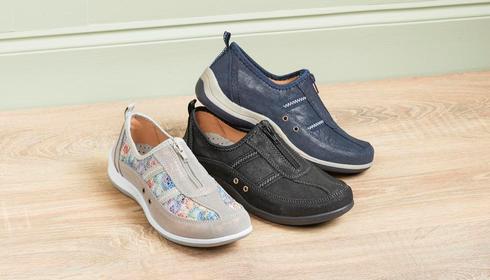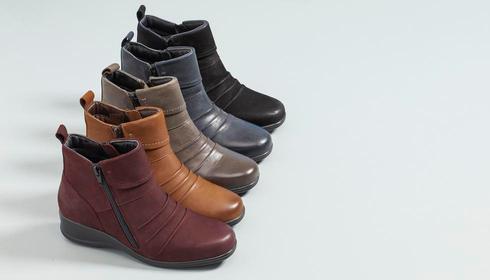
Buying Shoes for Flat Feet
17 December 2021
Flat feet, or fallen arches, are common and can generally be managed by wearing the right footwear.
If you think you might have fallen arches or you suffer from overpronation and need to know what features to look out for when buying shoes for flat feet – don’t fret because we’ve done all the leg work for you!
In this handy guide, you’ll learn all about the symptoms and the causes of flat feet. To help even further, we’ve also outlined the best overpronation shoes we have available today.
What are Flat Feet?
If you suffer from flat feet, then you’ll notice that your feet press flat against the floor when you’re standing or walking.
Medically known as pes planus or fallen arches, flat feet is a condition where the arches of the feet collapse or are naturally low, leading to the entire sole of the foot making contact with the ground.
While flat feet is a common foot posture found in both adults and children, its presence can sometimes lead to pain or discomfort, particularly after prolonged walking or standing.
What Causes Flat Feet?
Although flat feet isn’t a serious condition and may not cause you any pain, it can be incredibly uncomfortable. The main causes of flat feet are:
Another big risk factor for flat feet is wearing unsupportive footwear for long periods of time, such as flip flops or slippers.
What are the Symptoms of Flat Feet?
The good news is that lots of people who suffer from flat feet never experience any pain. That said, people who do not wear the right shoes for overpronation can suffer from several painful symptoms, such as:
- Leg cramps
- Knee pain
- Back pain
- Pain in the arch, ankle, heel or outside of the foot
Sometimes, flat feet may also lead to a condition known as toe drift. This is where the second toe drifts toward the big toe and eventually crosses over and lies on top of the big toe.
For this reason, if you have flat feet, you must make sure you’re using the right flat feet shoes regularly. These will help minimise or eliminate any pain you’re experiencing.
How do I know if I have Flat Feet?
To work out whether you have fallen arches, stand up straight with your feet on a level surface and look at the inside of your foot. If the middle part of your foot, between the heel and ball, lies flat on the ground, you have fallen arches. For more information and a more detailed guide, visit the NHS website.
Are Flat Feet a Problem?
Fallen arches aren’t generally something to worry about, but they can cause problems such as pain in the feet, ankles, knees, hips and even the neck. This is because the foot’s arch performs several functions. First, the arch absorbs the physical shock of each step, while also lending flexibility to the foot and driving power to push the foot off the ground. Additionally, the arch maintains even distribution of weight over the bottom of the foot, which helps with balance.
When the arch has fallen, these functions can be affected. One of the main issues caused by fallen arches is pronation of the foot, which means that the ankle slumps inwards. Without proper footwear, this can cause further problems over time, such as bunions.
If you’re experiencing a lot of pain that makes it difficult to walk or go about your daily life, seek the advice of your doctor, who might set you up with a pair of custom insoles designed to support your feet and reduce pain. In extreme cases, it might be necessary to see a foot specialist or physiotherapist. Your doctor will know what’s best for you.
Collapsed arch vs flat feet: how to tell the difference
Flat feet can also be known as ‘fallen arches’ or ‘collapsed arches’.
A ‘collapsed arch’ is a case of flat feet that developed in adulthood. In these cases, the individual used to have arches, but they have ‘collapsed’ and the person now has flat feet as a result. This usually happens when the ligament that supports the arch weakens. By contrast, most people who have flat feet are born with them.
If you notice that your arch is losing height over time and you’re suffering from an increased amount of pain and discomfort in your feet as a result, you should consult a medical professional.
What is overpronation and how does it link to flat feet?
People with flat feet often find that their feet roll inwards (pronate) as they either walk or stand. This is because their arches (the part of the foot that determines how they walk) have dropped. This rolling inwards is known as overpronation and can lead to the formation of bunions (hallux valgus).
People who do not have flat feet can distribute the impact across the entire foot as they walk or stand. This means that no single part of the foot takes too much stress or pressure. However, if you have flat feet or you overpronate, you’ll find that you cannot do this. Over time, this increase in pressure and strain on one part of the foot can lead to plantar fasciitis.
For this reason, if you suffer from flat feet or pronation problems, it’s vital that you find the right overpronation shoes for your needs. By purchasing the right footwear, you can ensure that you’re receiving the right level of comfort and support during daily activities. These shoes can also help prevent much worse foot conditions, such as bunions and plantar fasciitis, from occurring.
What Shoes are Best for Flat Feet?
When it comes to flat feet not all shoes are created equal. Many of us may wonder, 'What shoes should I wear for flat feet?' Picking the right footwear isn't just about style; it's about comfort, support, and ensuring those feet of yours feel fabulous, even after a long day on the move. Let's delve into the best choices for those with flatter feet.
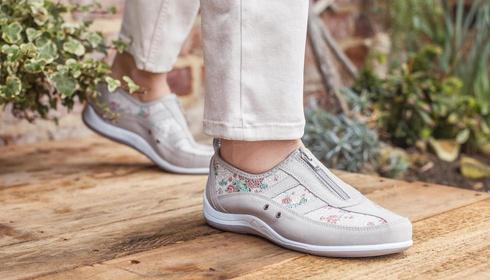
There are several key features to look out for when shopping for shoes to suit flat feet. Not all the features listed below will be perfect for your needs. Think about shoes you’ve enjoyed wearing in the past, did they have some of the features below? For the best results, try on shoes before deciding they’re a suitable fit. Visit one of our stores and chat to our friendly customer assistants who are always happy to help you find the right footwear for your needs.
Buying Shoes for Flat Feet: the features to look for
Adjustable
Touch-fasten straps or zips can help the overall fit of your shoe, as throughout the course of the day you are able to adjust your shoes to suit your needs. A comfortable, snug fit, aided by an adjustable strap, can lend stability to the foot and help to prevent the ankle from rolling inwards.
Low Heel
It’s best to avoid extremes when it comes to heel height, huge heels or flat-to-the-floor flats can cause their own issues. The best heels for flat feet are relatively low, providing only a little elevation, giving you a boost whilst taking the pressure off a fallen arch.
Arch Support
Good arch support will be structured enough to support the arch of the foot, but not so rigid as to cause further pain. If a shoe has arch support, you will see a raised contoured section of the footbed where the arch of the foot sits. This helps to gently raise the arch and restore it to its natural position.
Material
Breathable and flexible material, such as leather, is best. Not only will the shoes fair better and last longer, but leather can also be ‘broken in’ making the shoes a more comfortable fit with time.
Wide Fit and Toe-Box
A wider fitting shoe helps to accommodate the shape of the foot and leaves plenty of room for your toes to prevent cramping. Similarly, a deep and wide toe-box prevents uncomfortable, squashed toes and other problems such as bunions.
Removeable Insoles
Removable insoles can be left in for more general support or replaced with prescription insoles from your doctor, tailor-made to your needs.
Durability
When you have flat feet, it’s important to keep an eye on the wear pattern of your outsoles. You might find that the inside heel of your outsole is more worn than the outside.
People with flat feet tend to wear out their shoes (particularly the tread) quicker than people with more defined arches. When looking to buy a new pair of shoes, think about their durability. Buying a good quality pair of shoes, that won’t wear out as quickly, could save you money in the long run.
Cushioning
A cushioned insole can help to redistribute the weight across the whole foot and alleviate pain and provide support. For this reason, you should consider a memory foam insole, which moulds to the shape of your foot over time.
When you wear a memory foam insole, your shoes will become more comfortable the more you wear them. Fly Flot can offer an anatomic fit, meaning that the shoe is designed to be specifically shaped to fit the contours of the foot.
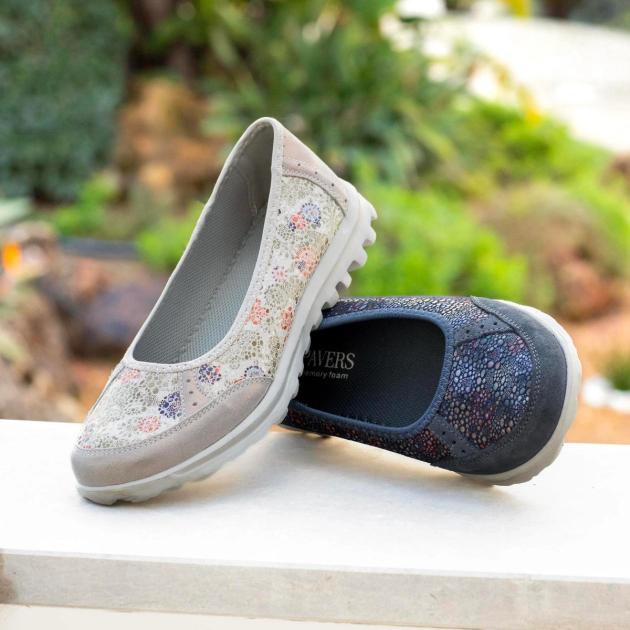
Our Best Shoes for Flat Feet
Now you know what causes flat feet, what the symptoms are, and the features you should look for in a pair of shoes. So, without any further delay, let’s take a look at the best shoes for fallen arches.
Best Chelsea Boots for Flat Feet
Our Favourite Boots
Made in Italy, these Chelsea boots by Fly Flot feature the brand’s anatomic footbed technology and a memory foam insole. This means that not only is the footbed shaped to fit the foot, but with long-term wear the footbed moulds to fit and support the wearer’s feet. This makes these shoes exceptionally comfortable.
Made from flexible and durable leather in a wider fit, these boots have a wide toe box that prevents the squashing of the toes. The anti-shock sole absorbs the impact of each step, for maximum comfort all day long, while the low heel redistributes weight and supports the function of the foot’s arch.
On top of all these features, these shoes also benefit from anti-slip soles and twin elastic inserts on either side for quick and easy pull-on and go. For this reason, in our opinion, these are some of the best shoes for flat feet on the market today.
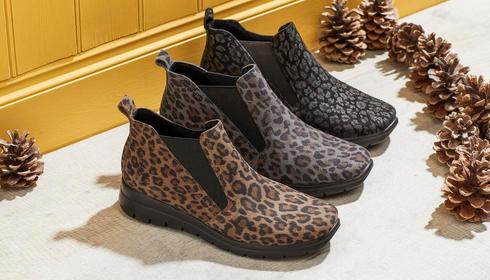
Best Trainers for Flat Feet
Zip Fastening Trainers
Made from shimmering leather, these comfortable trainers offer both a flexible upper and insole with additional arch and ankle support. Their contoured dual density outsole offers durability, while the slightly raised heel lends support and stability. A rounded toe means there is plenty of room for the toes.
Although not in a wider fit, these trainers feature a top zip, as a fetching added detail and to allow the wearer to adjust the shoe’s fit over the top of the foot. An easy slip-on design and lightweight sole make these trainers a great choice for everyday comfortable wear.
Best Boots for Flat Feet
Leather Ankle Boots
Perfect for smart or casual occasions these boots are made of supple, long-lasting leather and fastened with zips for a secure fit. The low heel is a hybrid between a block and wedge, helping to distribute weight evenly across the bottom of the foot for maximum comfort.
Made for women who need a wider fit, the rounded toe box means there’s plenty of space for the toes. The back of each boot is tapered to fit and support the ankle, helping to prevent the feet from rolling inwards. Lined with leather, the footbed is cushioned for a thoroughly comfortable experience. This style is completed by a sophisticated ruche detail, and dual zips on either side of the boot to allow easier put-on.
Best Clogs for Flat Feet
Anatomic Wide Fit Clogs
These mule clogs by Fly Flot feature the same anatomic support as the Chelsea boots above. Featuring the same self-molding cushioned leather footbed, these clogs are great for anyone struggling with flat feet who are looking for comfort. The anti-shock outsole absorbs the impact of walking and is slightly elevated at the heel, offering greater support. Made in Italy, using genuine durable leather, these slippers are designed for wider feet with plenty of room for the toes.
Fly Flot’s ever-popular clogs come in a range of colours, each offering consistently high-quality comfort and support.
Don’t Suffer with Your Foot Health
We have several handy blogs with plenty of information on coping with a range of different foot problems. Check them out below.

